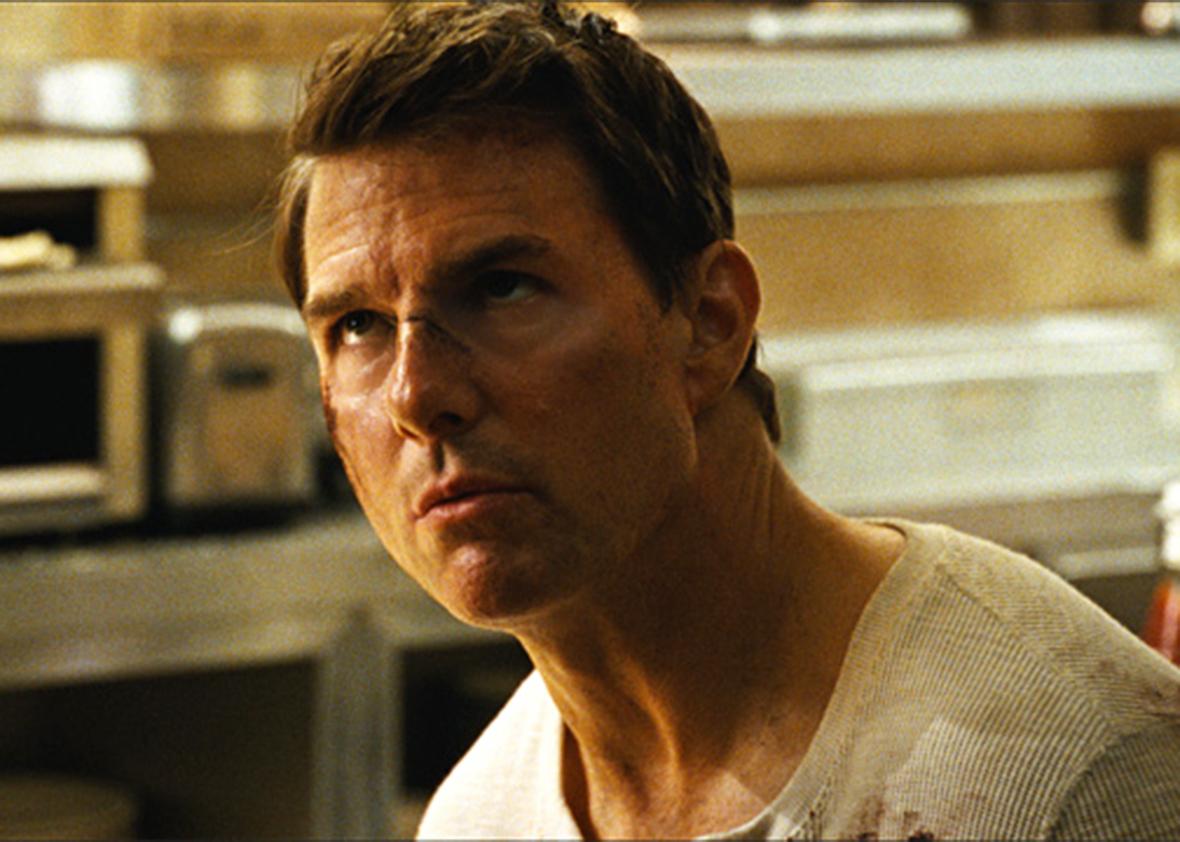Jack Reacher, Christopher McQuarrie’s 2012 adaptation of Lee Child’s series of novels, had the bad fortune to open with a lovingly detailed mass shooting scene a week after Sandy Hook. But for audiences willing to overlook its Vaughn Meader–esque timing, it offered two genuine pleasures. The first was seeing Tom Cruise, whose movie star persona might generously be described as “managed,” play an action hero who was a bona fide jerk. The second was seeing Werner Herzog chewing the scenery as a villain with a penchant for chewing fingers.
The sequel, Jack Reacher: Never Go Back, directed by Edward Zwick from a screenplay by Richard Wenk, Zwick, and Marshall Herskovitz, unfortunately offers neither. Herzog has been replaced by Patrick Heusinger, who does what he can as an unstoppable killing machine but is crippled by the fact that he is not Werner Herzog. Worse yet, Cruise, the film’s producer, inexplicably decides that the second film would be a good time to soften and humanize a character whose sole appeal was his implacable inhumanity.
This time around Reacher, an itinerant ex-military police officer who roams America righting wrongs, returns to his former unit hoping to take Maj. Susan Turner (Cobie Smulders) out for dinner. All signs point to romance: They’ve been flirting over the phone, and Reacher’s sent her a few gifts, like the human-trafficking ring he ties up with a bow and delivers in the opening scene. But when he arrives in D.C., he discovers Turner has been relieved of command and charged with espionage; what’s more, he’s been recalled to active duty under an emergency provision in his discharge papers. The “emergency” is that a corrupt military officer (Holt McCallany) wants to have jurisdiction over Reacher’s prosecution for a murder he’s framed him for, to make it easier to kill Reacher himself.
Here is how Jack Reacher and Susan Turner deal with their problems: Run run run run run. The first half of the film is overstuffed with shots of Cruise and Smulders tear-assing over field and dale, karate chopping the air in front of them with each stride so you can tell they’re military. Things get more complicated once Reacher’s putative 15-year-old daughter Samantha (Danika Yarosh) is sucked into the conspiracy: As if murder and espionage charges weren’t enough, Reacher’s facing a paternity suit. Despite possibly sharing Reacher DNA, Samantha’s not as talented at running. Soon, this improvised family is on their way to New Orleans in search of location tax credits—sorry, in search of their only lead, a man named (really!) Prudhomme.
Saddling an action hero with a teenage sidekick is almost never a good idea, but it doesn’t have to be a franchise-killing disaster: Indiana Jones has somehow survived this indignity twice. And making Jack Reacher—the guy who called a 19-year-old he’d just met a slut in the previous movie—struggle with the trappings of domesticity and his own James Bond–ian misogyny might even be interesting, though that movie would feel just as exhaustingly ill-timed as the mass shooting in the first film. But Samantha never feels real—she transforms within moments from a traumatized kid who’s been kidnapped by strangers after seeing her foster parents shot to death into a sullen teen fighting with Cruise and Smulders over texting and curfews. And so Reacher’s supposed softening feels forced—especially because nearly every interaction Reacher has with his daughter is punctuated by a reaction shot of Cobie Smulders melting, coaching the audience how to feel.
No matter how insipid the reaction shots are, you have to give them one thing: They’re not on screen for very long. Nothing is! Sometimes the film’s frenetic pace works, as in a brutally efficient half-second fight in an airplane bathroom. But more often, it feels like cinematographer Oliver Wood and editor Billy Weber are feuding: Wood will capture one of the film’s occasional striking images—a diagonal overhead shot during a cage fight, for example—and Weber cuts away before it lands, never to return. (Weber has the distinction of having edited both Days of Heaven and Days of Thunder; neither felt as manic as this.) The high point, such as it is, is in the sound design: A rooftop shootout during a fireworks show snaps, crackles, and pops better than anything in the visuals.
Still, there’s probably no level of craft that would save a film in which a teenager’s first words after watching Jack Reacher slowly, methodically beat someone else to death are, “Dude, you jumped off a building!” If you watched Cruise bruise his way through the first Reacher film and thought, “I wonder if that guy’s good with kids?” this is exactly the movie you’ve been waiting for. Otherwise: Run run run run run.
